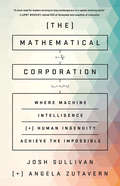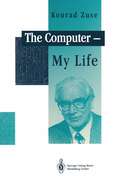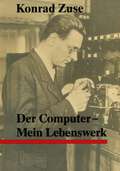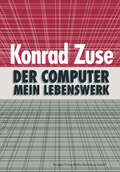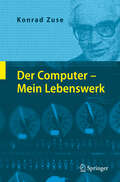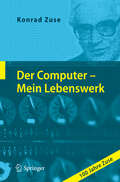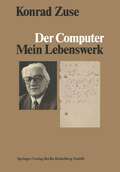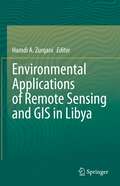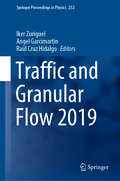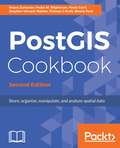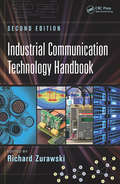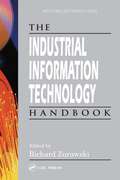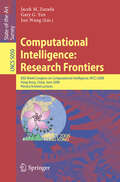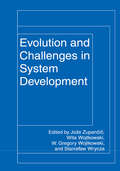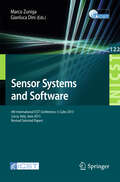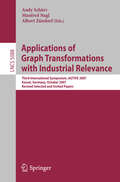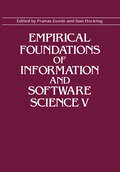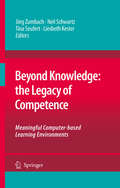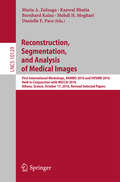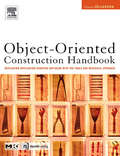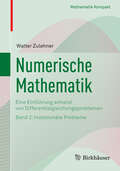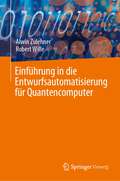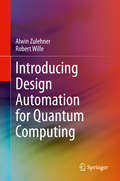- Table View
- List View
The Mathematical Corporation: Where Machine Intelligence and Human Ingenuity Achieve the Impossible
by Angela Zutavern Josh SullivanThe most powerful weapon in business today is the alliance between the mathematical smarts of machines and the imaginative human intellect of great leaders. Together they make the mathematical corporation, the business model of the future. We are at a once-in-a-decade breaking point similar to the quality revolution of the 1980s and the dawn of the internet age in the 1990s: leaders must transform how they run their organizations, or competitors will bring them crashing to earth--often overnight. Mathematical corporations--the organizations that will master the future--will outcompete high-flying rivals by merging the best of human ingenuity with machine intelligence. While smart machines are weapon number one for organizations, leaders are still the drivers of breakthroughs. Only they can ask crucial questions to capitalize on business opportunities newly discovered in oceans of data. This dynamic combination will make possible the fulfillment of missions that once seemed out of reach, even impossible to attain. Josh Sullivan and Angela Zutavern's extraordinary examples include the entrepreneur who upended preventive health care, the oceanographer who transformed fisheries management, and the pharmaceutical company that used algorithm-driven optimization to boost vaccine yields. Together they offer a profoundly optimistic vision for a dazzling new phase in business, and a playbook for how smart companies can manage the essential combination of human and machine.
Der Computer: Mein Lebenswerk
by Konrad ZuseDas Werk eines großen Mannes in wenigen Worten zusammenzu fassen, wird notwendig, wenn diese Worte in Stein gemeißelt werden sollen. Auch im Geleitwort zur Autobiographie eines solchen Mannes ist es angebracht, Kürze walten zu lassen und durch wenig Worte den Autor um so mehr zu ehren. Für Konrad Zuse lauten diese Worte: Schöpfer der ersten vollautomatischen, programmgesteuer ten und frei programmierten, in binärer Gleitpunktrechnung arbeitenden Rechenanlage. Sie war 1941 betriebsfähig. So oder ähnlich wird man einmal schreiben müssen, wenn Konrad Zuses Büste in der Walhalla neben denen Gregor Mendels und Wilhelm Conrad Röntgens - um nur zwei zu nennen, denen zuletzt diese Ehre zuteil wurde - aufgestellt wird. München,August1984 F. L. Bauer v GELEITWORT Wie lange und ausführlich immer eine Autobiographie ist, sie kann nicht vollständig sein. Ich freue mich daher, in diesem Geleitwort ein Beispiel dafür anführen zu können, wie das Werk des Verfassers ausgestrahlt hat. Es ist ein kleines Beispiel, von einer Art wie es Dutzende geben mag, aber ein persönliches, das als mein Dank für die Anregung und Unterstützung - die zu einer dauerhaften Freundschaft geführt hat - gelten darf, aber auch als symbolischer Dank aller anderen, die von Konrad Zuse Richtung und Hilfe erhalten haben.
Der Computer - Mein Lebenswerk
by Konrad ZuseAutobiografie des Pioniers Konrad Zuse: Er baute den ersten funktionsfähigen Computer, der 1941 betriebsfähig war. Zuse erzählt hier die Geschichte seines Lebens, das wie kaum ein anderes mit der bedeutendsten technischen Entwicklung seines Jahrhunderts verbunden ist. Aus den Rezensionen: "… eine faszinierende Lektüre, weil aus jeder Zeile das persönliche Erleben des Autors spricht…" (in: ntz Nachrichtentechnische Zeitschrift) "... Für entspannende und erholsame Stunden, informativ und allgemeinbildend, eigentlich genau das, was im Zusammenhang mit dem Thema Computer sehr oft gefragt und verlangt wird... Unser Tipp: Sehr empfehlenswert!" (in: PASCAL)
Der Computer - Mein Lebenswerk
by Konrad ZuseDer erste funktionsfähige Computer wurde von Konrad Zuse gebaut. Diese vollautomatische, programmgesteuerte, frei programmierbare, in binärer Gleitpunktzahlrechnung arbeitende Rechenanlage war 1941 betriebsbereit. Anlässlich des 100. Geburtstages von Konrad Zuse (22. Juni 2010), der mit einem Zuse-Jahr begangen wird, erscheint die Autobiografie des Computer-Pioniers in einer Sonderauflage. Er erzählt darin die Geschichte seines Lebens und liefert zugleich eine eindrucksvolle Darstellung der Anfänge des Computer-Zeitalters.
Environmental Applications of Remote Sensing and GIS in Libya
by Hamdi A. ZurqaniThis book addresses the environmental challenges that Libya and similar countries in the regions are currently facing. Each chapter of this book provides a methodology using remote sensing (RS) and geographical information systems (GIS) dealing with one of these environmental challenges such as monitoring and mapping soil salinity and prediction of soil properties, monitoring and mapping of land degradation, spatiotemporal land use/cover, agricultural drought monitoring, hydrological applications such as spatial rainfall distribution, surface runoff, geo-morphometric analysis, flood hazard assessment and mapping, hydrologic and hydraulic modeling, pollution hazard assessment, and climate-related geophysical processes. This book also assesses the impacts of climate change on natural resources using both RS and GIS, as well as other applications, covering different parts of Libya. This book is beneficial for graduate students, researchers, policy planners, and stakeholders in Libya as well as other countries that share similar environmental issues. Also, the methodologies followed in the book's chapters can be applied to any other regions around the world with similar landscapes and climatic conditions.
Traffic and Granular Flow 2019 (Springer Proceedings in Physics #252)
by Iker Zuriguel Angel Garcimartín Raúl Cruz HidalgoThis book gathers contributions on a variety of flowing collective systems. While primarily focusing on pedestrian dynamics, they also reflect the latest developments in areas such as vehicular traffic and granular flows and address related emerging topics such as self-propelled particles, data transport, swarm behavior, intercellular transport, and collective dynamics of biological systems. Combining fundamental research and practical applications in the various fields discussed, the book offers a valuable asset for researchers and practitioners alike.
PostGIS Cookbook - Second Edition
by Mayra Zurbaran Pedro M. Wightman Paolo Corti Stephen Vincent Mather Thomas J Kraft Bborie ParkCreate and manage spatial data with PostGISAbout This BookImport and export geographic data from the PostGIS database using the available toolsMaintain, optimize, and fine-tune spatial data for long-term viabilityUtilize the parallel support functionality that was introduced in PostgreSQL 9.6Who This Book Is ForThis book is for developers who need some quick solutions for PostGIS. Prior knowledge of PostgreSQL and spatial concepts would be an added advantage.What You Will LearnImport and export geographic data from the PostGIS database using the available toolsStructure spatial data using the functionality provided by a combination of PostgreSQL and PostGISWork with a set of PostGIS functions to perform basic and advanced vector analysesConnect PostGIS with PythonLearn to use programming frameworks around PostGISMaintain, optimize, and fine-tune spatial data for long-term viabilityExplore the 3D capabilities of PostGIS, including LiDAR point clouds and point clouds derived from Structure from Motion (SfM) techniquesDistribute 3D models through the Web using the X3D standardUse PostGIS to develop powerful GIS web applications using Open Geospatial Consortium web standardsMaster PostGIS RasterIn DetailPostGIS is a spatial database that integrates the advanced storage and analysis of vector and raster data, and is remarkably flexible and powerful. PostGIS provides support for geographic objects to the PostgreSQL object-relational database and is currently the most popular open source spatial databases.If you want to explore the complete range of PostGIS techniques and expose related extensions, then this book is for you.This book is a comprehensive guide to PostGIS tools and concepts which are required to manage, manipulate, and analyze spatial data in PostGIS. It covers key spatial data manipulation tasks, explaining not only how each task is performed, but also why. It provides practical guidance allowing you to safely take advantage of the advanced technology in PostGIS in order to simplify your spatial database administration tasks. Furthermore, you will learn to take advantage of basic and advanced vector, raster, and routing approaches along with the concepts of data maintenance, optimization, and performance, and will help you to integrate these into a large ecosystem of desktop and web tools.By the end, you will be armed with all the tools and instructions you need to both manage the spatial database system and make better decisions as your project's requirements evolve.Style and approachThis comprehensive guide uses a problem-solving approach to help you acquire a solid understanding of PostGIS.
Industrial Communication Technology Handbook (Industrial Information Technology #8)
by Richard ZurawskiFeaturing contributions from major technology vendors, industry consortia, and government and private research establishments, the Industrial Communication Technology Handbook, Second Edition provides comprehensive and authoritative coverage of wire- and wireless-based specialized communication networks used in plant and factory automation, automotive applications, avionics, building automation, energy and power systems, train applications, and more. New to the Second Edition: 46 brand-new chapters and 21 substantially revised chapters Inclusion of the latest, most significant developments in specialized communication technologies and systems Addition of new application domains for specialized networks The Industrial Communication Technology Handbook, Second Edition supplies readers with a thorough understanding of the application-specific requirements for communication services and their supporting technologies. It is useful to a broad spectrum of professionals involved in the conception, design, development, standardization, and use of specialized communication networks as well as academic institutions engaged in engineering education and vocational training.
Industrial Communication Technology Handbook (Industrial Information Technology)
by Richard ZurawskiFeaturing contributions from major technology vendors, industry consortia, and government and private research establishments, the Industrial Communication Technology Handbook, Second Edition provides comprehensive and authoritative coverage of wire- and wireless-based specialized communication networks used in plant and factory automation, automotive applications, avionics, building automation, energy and power systems, train applications, and more. New to the Second Edition: 46 brand-new chapters and 21 substantially revised chapters Inclusion of the latest, most significant developments in specialized communication technologies and systems Addition of new application domains for specialized networks The Industrial Communication Technology Handbook, Second Edition supplies readers with a thorough understanding of the application-specific requirements for communication services and their supporting technologies. It is useful to a broad spectrum of professionals involved in the conception, design, development, standardization, and use of specialized communication networks as well as academic institutions engaged in engineering education and vocational training.
The Industrial Information Technology Handbook (Industrial Electronics)
by Richard ZurawskiThe Industrial Information Technology Handbook focuses on existing and emerging industrial applications of IT, and on evolving trends that are driven by the needs of companies and by industry-led consortia and organizations. Emphasizing fast growing areas that have major impacts on industrial automation and enterprise integration, the Handbook covers topics such as industrial communication technology, sensors, and embedded systems.The book is organized into two parts. Part 1 presents material covering new and quickly evolving aspects of IT. Part 2 introduces cutting-edge areas of industrial IT. The Handbook presents material in the form of tutorials, surveys, and technology overviews, combining fundamentals and advanced issues, with articles grouped into sections for a cohesive and comprehensive presentation. The text contains 112 contributed reports by industry experts from government, companies at the forefront of development, and some of the most renowned academic and research institutions worldwide. Several of the reports on recent developments, actual deployments, and trends cover subject matter presented to the public for the first time.
Computational Intelligence: IEEE World Congress on Computational Intelligence, WCCI 2008, Hong Kong, China, June 1-6, 2008, Plenary/Invited Lectures (Lecture Notes in Computer Science #5050)
by Jacek M. Zurada Gary G. Yen Jun WangThe 2008 IEEE World Congress on Computational Intelligence (WCCI 2008), held during June 1–6, 2008 in Hong Kong, China, marked an important milestone in advancing the paradigms of the new fields of computational intelligence. As the fifth event in the series that has spanned the globe (Orlando-1994, Anchorage-1998, Honolulu-2002, Vancouver-2006), the congress offered renewed and refreshing focus on the progress in nature-inspired and linguistically motivated computation. Most of the congress’s program featured regular and special technical sessions that provided participants with new insights into the most recent developments in the field. As a tradition, in addition to the parallel technical sessions, WCCI holds a series of plenary and invited lectures which are not included in the congress proceedings. As its predecessors, at WCCI 2008, 20 expert speakers shared their expertise on broader, if not panoramic, topics spanning a diverse spectrum of computational intelligence in the areas of neurocomputing, fuzzy systems, evolutionary computation, and adjacent areas. Thanks to their time and expertise, we endeavored to offer this volume to attendees directly at the congress and the general public afterwards.
Evolution and Challenges in System Development
by Joze Zupancic W. Gregory Wojtkowski Wita Wojtkowski Stanislaw WryczaThis book is a result of the Seventh International Conference on Information Sys tems Development-Methods and Tools, Theory and Practice held in Bled, Slovenia, Sep tember 21-23, 1998. The purpose of the conference was to address issues facing academia and industry when specifying, developing, managing, and improving information comput erized systems. During the past few years, many new concepts and approaches emerged in the Information Systems Development (ISD) field. The various theories, methods, and tools available to system developers also bring problems such as choosing the most effec tive approach for a specific task. This conference provides a meeting place for IS re searchers and practitioners from Eastern and Western Europe as well as from other parts of the world. An objective of the conference is not only to share scientific knowledge and in terests but to establish strong professional ties among the participants. The Seventh International Conference on Information Systems Develop ment-ISD'98 continues the concepts of the first Polish-Scandinavian Seminar on Current Trends in Information Systems Development Methodologies held in Gdansk, Poland in 1988. Through the years, the Seminar developed into the International Conference on In formation Systems Development. ISD'99 will be held in Boise, Idaho. The selection of papers was carried out by the International Program Committee. All papers were reviewed in advance by three people. Papers were judged according to their originality, relevance, and presentation quality. All papers were judged only on their own merits, independent of other submissions.
Sensor Systems and Software: 4th International ICST Conference, S-Cube 2013, Lucca, Italy, June 11-12, 2013, Revised Selected Papers (Lecture Notes of the Institute for Computer Sciences, Social Informatics and Telecommunications Engineering #122)
by Marco Zuniga Gianluca DiniThis book constitutes the thoroughly refereed post-conference proceedings of the 4th International ICST Conference on Sensor Systems and Software, S-Cube 2013, held in Lucca, Italy, 2013. The 8 revised full papers and 2 invited papers presented cover contributions on different technologies for wireless sensor networks, including security protocols, middleware, analysis tools and frameworks.
Applications of Graph Transformations with Industrial Relevance: Third International Symposium, AGTIVE 2007, Kassel, Germany, October 10-12, 2007, Revised Selected and Invited Papers (Lecture Notes in Computer Science #5088)
by Albert Zündorf Andy Schürr Manfred NaglThis book constitutes the thoroughly refereed post-conference proceedings of the Third International Symposium on Applications of Graph Transformations, AGTIVE 2007, held in Kassel, Germany, in October 2007. The 30 revised full papers presented together with 2 invited papers were carefully selected from numerous submissions during two rounds of reviewing and improvement. The papers are organized in topical sections on graph transformation applications, meta-modeling and domain-specific language, new graph transformation approaches, program transformation applications, dynamic system modeling, model driven software development applications, queries, views, and model transformations, as well as new pattern matching and rewriting concepts. The volume moreover contains 4 papers resulting from the adjacent graph transformation tool contest and concludes with 9 papers summarizing the state of the art of today's available graph transformation environments.
Empirical Foundations of Information and Software Science V
by Pranas Zunde D. HockingThis is the proceedings of the Sixth Symposium on Empirical Foundations of Information and Software Sciences (EFISS), which was held in Atlanta, Georgia, on October 19-21, 1988. The purpose of the symposia is to explore subjects and methods of scientific inquiry which are of common interest to information and software sciences, and to identify directions of research that would benefit from the mutual interaction of these two disciplines. The main theme of the sixth symposium was modeling in information and software engineering, with emphasis on methods and tools of modeling. The symposium covered topics such as models of individual and organizational users of information systems, methods of selecting appropriate types of models for a given type of users and a given type of tasks, deriving models from records of system usage, modeling system evolution, constructing user and task models for adaptive systems, and models of system architectures. This symposium was sponsored by the School of Information and Computer Science of the Georgia Institute of Technology and by the U.S. Army Institute for Research in Management Information, Communications, and Computer Sciences (AIRMICS). 17le Editors vii CONTENTS 1 I. KEYNOTE ADDRESS ............................................. .
Beyond Knowledge: Meaningful Computer-based Learning Environments
by Jörg Zumbach Liesbeth Kester Neil Schwartz Tina SeufertThe edited and peer reviewed volume presents selected papers of the conference “Beyond knowlegde: the legacy of competence” organized by EARLI SIG Learning and Instruction with Computers in cooperation with SIG Instructional Design. It reflects the current state-of-the-art work of scholars worldwide within the area of learning and instruction with computers. Mainly, areas of computer-based learning environments supporting competence-focused knowledge acquisition but also foundational scientific work are addressed. More specific, contents cover cognitive processes in hypermedia and multimedia learning, social issues in computer-supported collaborative learning, motivation and emotion in Blended Learning and e-Learning.
Reconstruction, Segmentation, and Analysis of Medical Images: First International Workshops, RAMBO 2016 and HVSMR 2016, Held in Conjunction with MICCAI 2016, Athens, Greece, October 17, 2016, Revised Selected Papers (Lecture Notes in Computer Science #10129)
by Maria A. Zuluaga Kanwal Bhatia Bernhard Kainz Mehdi H. Moghari Danielle F. PaceThis book constitutes the refereed proceedings of two workshops held at the 19th International Conference on Medical Image Computing and Computer-Assisted Intervention, MICCAI 2016, in Athens, Greece, in October 2016: the First International Workshop on Reconstruction and Analysis of Moving Body Organs, RAMBO 2016, and the First International Workshop on Whole-Heart and Great Vessel Segmentation from 3D Cardiovascular MRI in Congenital Heart Disease, HVSMR 2016. The 17 revised regular papers presented in this book were carefully reviewed and selected from a total of 21 submissions. The papers cover following topics: Registration; Reconstruction; Deep learning for heart segmentation; Discrete optimization and probabilistic intensity modeling; Atlas-based strategies; Random forests.
Object-Oriented Construction Handbook: Developing Application-Oriented Software with the Tools & Materials Approach
by Heinz ZüllighovenSuccessful businesses and organizations are continually looking for ways to improve service and customer satisfaction in order to achieve long-term customer loyalty. In light of these goals, software developers must ask the question: how does customer orientation influence traditional approaches, methods, and principles of software development? In this book, a leading software architect and his team of software engineers describe how the idea of customer orientation in an organization leads to the creation of application-oriented software. This book describes what application-oriented software development is and how it can be conceptually and constructively designed with object-oriented techniques. It goes further to describe how to best fit together the many different methodologies and techniques that have been created for object-orientation (such as frameworks, platforms, components, UML, Unified Process, design patterns, and eXtreme Programming) to design and build software for real projects. This book brings together the best of research, development, and day-to-day project work to the task of building large software systems.*Written by and for developers of large, interactive, and long-lived software systems*Includes patterns of proven analysis, design, and documentation techniques*Shows how to develop an appropriate design approach and concrete software development techniques
Hands-on ESP32 with Arduino IDE: Unleash the power of IoT with ESP32 and build exciting projects with this practical guide
by Asim ZulfiqarBuild a strong foundation in IoT development and take your skills to the next level by mastering ESP32 and Arduino IDE 2.0, learning IoT protocols, and automating your projectsKey FeaturesLearn how to Interface ESP32 with various components for IoT projectsUnderstand IoT protocols and automation theories with practical examplesImplement automation and IoT knowledge in ESP32 projects for real-world applicationsPurchase of the print or Kindle book includes a free PDF eBookBook DescriptionESP32 is a versatile microcontroller and a great starting point for anyone venturing into the IoT realm, but its configuration and interfacing of sensors can be challenging for new users. Arduino Integrated Development Environment (IDE) simplifies programming, uploading code, and utilization of ESP32 capabilities, enabling users to incorporate it into their IoT projects with ease. This book will help you learn the essentials of sensing, networking, data processing, and applications with ESP32, laying a strong foundation for further IoT development. Starting with ESP32 and Arduino Ide 2.0 basics, you'll first explore practical implementation examples of interfacing sensors with ESP32. These examples will also teach you how to interface the ESP32 camera and display modules with ESP32. As you progress, you’ll get to grips with IoT network and data protocols, as well as the many options they unlock within IoT applications. The book will also help you leverage your newly acquired knowledge with exciting projects ranging from smart connected devices to data loggers and automation. By the end of this book, you'll confidently navigate ESP32 projects with newfound knowledge and skills, know what IoT protocol to select for your applications, and successfully build and deploy your own IoT projects.What you will learnUnderstand the architecture of ESP32 including all its ins and outsGet to grips with writing code for ESP32 using Arduino IDE 2.0Interface sensors with ESP32, focusing on the science behind itFamiliarize yourself with the architecture of various IoT network protocols in-depthGain an understanding of the network protocols involved in IoT device communicationEvaluate and select the ideal data-based IoT protocol for your project or applicationApply IoT principles to real-world projects using Arduino IDE 2.0Who this book is forThis book is for electronics enthusiasts, hobbyists, and other professionals looking to design IoT applications utilizing ESP32. While it’s designed to be accessible for beginners, a basic understanding of electronics and some experience with programming concepts is a prerequisite.
Numerische Mathematik: Eine Einführung anhand von Differentialgleichungsproblemen Band 2: Instationäre Probleme (Mathematik Kompakt)
by Walter Zulehner"Numerische Mathematik", in zwei Bänden, ist eine Einführung in die Numerische Mathematik anhand von Differenzialgleichungsproblemen. Gegliedert nach elliptischen, parabolischen und hyperbolischen Differenzialgleichungen, erläutert sie zunächst jeweils die Diskretisierung solcher Probleme. Als Diskretisierungstechniken stehen Finite-Elemente-Methoden im Raum und (partitionierte) Runge-Kutta-Methoden in der Zeit im Vordergrund. Die diskretisierten Gleichungen motivieren die Diskussion von Methoden für endlichdimensionale (nicht)lineare Gleichungen, die anschließend als eigenständige Themen behandelt werden. Ein in sich geschlossenes Bild.
Einführung in die Entwurfsautomatisierung für Quantencomputer
by Alwin Zulehner Robert WilleDieses Buch bietet dem Leser einen einfachen Einstieg in das Quantencomputing sowie in den Entwurf entsprechender Geräte. Die Autoren behandeln verschiedene Entwurfsaufgaben, die für das Quantencomputing wichtig sind, und stellen entsprechende Lösungen vor. Eine Besonderheit des Buches ist, dass diese Aufgaben und Lösungen explizit aus der Perspektive der Entwurfsautomatisierung diskutiert werden, d.h. unter Verwendung von cleveren Algorithmen und Datenstrukturen, die von der Entwurfsautomatisierungs-Community für konventionelle Logik (d.h. für elektronische Geräte und Systeme) entwickelt worden sind und nun für diese neue Technologie angewendet werden. Auf diese Weise können relevante Entwurfsaufgaben wesentlich effizienter als bisher durchgeführt werden, was zu Verbesserungen um mehrere Größenordnungen führt (in Bezug auf die Laufzeit und andere Entwurfsziele). Beschreibt den aktuellen Stand der Technik für den Entwurf von Quantenschaltungen, für deren Simulation und für deren Abbildung auf reale Hardware; Bietet eine erste umfassende Einführung in die Entwurfsautomatisierung für Quantencomputer, die sich mit praxisrelevanten Aufgabenstellungen befasst; Es richtet sich sowohl an die Quantencomputer-Gemeinschaft als auch an die Gemeinschaft der Entwurfsautomatisierung und zeigt, welche beeindruckenden Verbesserungen möglich sind, wenn man das Wissen beider Gemeinschaften kombiniert.
Introducing Design Automation for Quantum Computing
by Alwin Zulehner Robert WilleThis book offers readers an easy introduction into quantum computing as well as into the design for corresponding devices. The authors cover several design tasks which are important for quantum computing and introduce corresponding solutions. A special feature of the book is that those tasks and solutions are explicitly discussed from a design automation perspective, i.e., utilizing clever algorithms and data structures which have been developed by the design automation community for conventional logic (i.e., for electronic devices and systems) and are now applied for this new technology. By this, relevant design tasks can be conducted in a much more efficient fashion than before – leading to improvements of several orders of magnitude (with respect to runtime and other design objectives).Describes the current state of the art for designing quantum circuits, for simulating them, and for mapping them to real hardware;Provides a first comprehensive introduction into design automation for quantum computing that tackles practically relevant tasks;Targets the quantum computing community as well as the design automation community, showing both perspectives to quantum computing, and what impressive improvements are possible when combining the knowledge of both communities.
